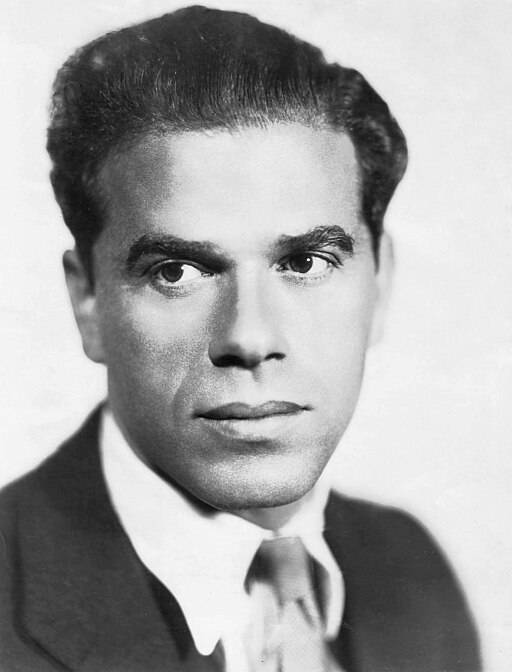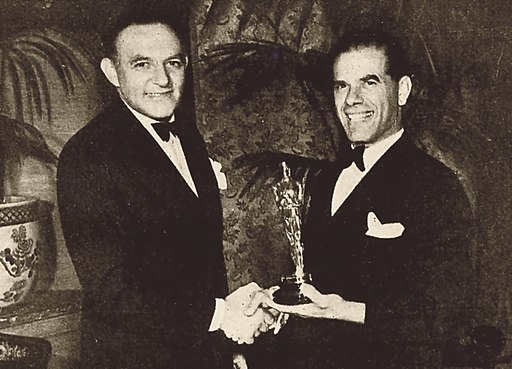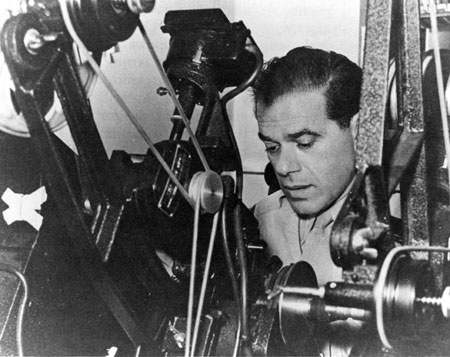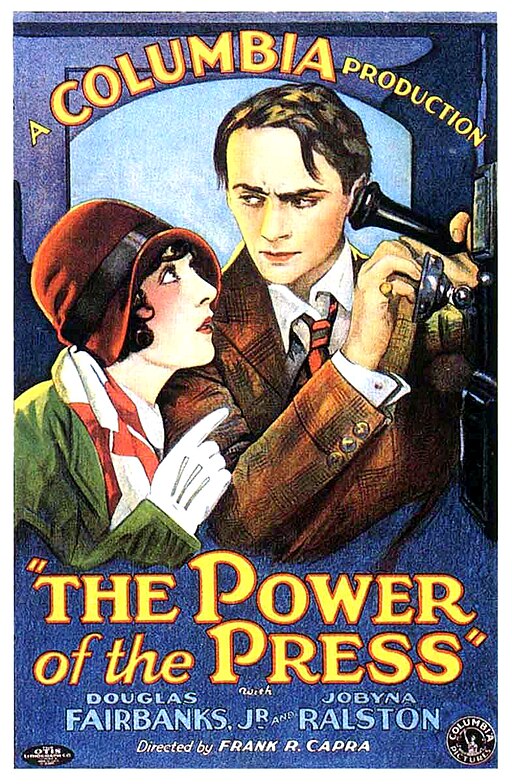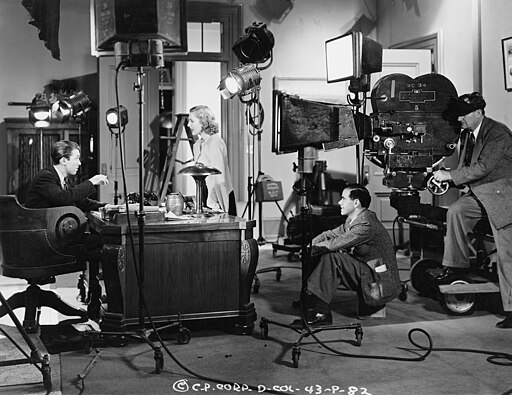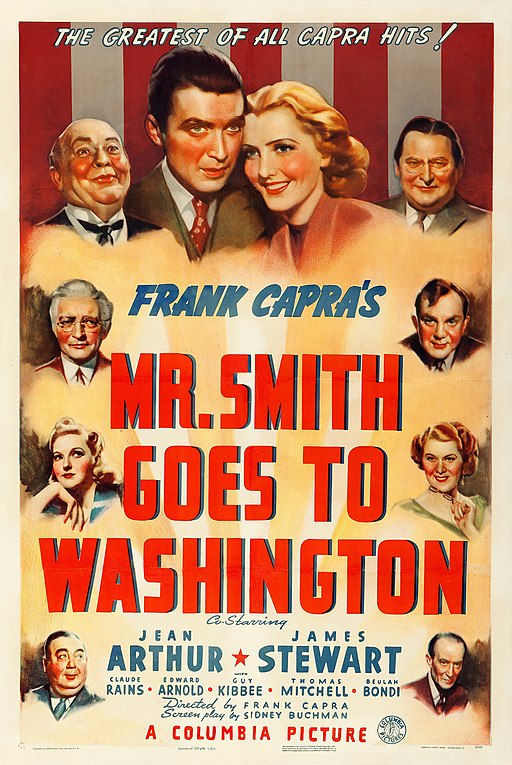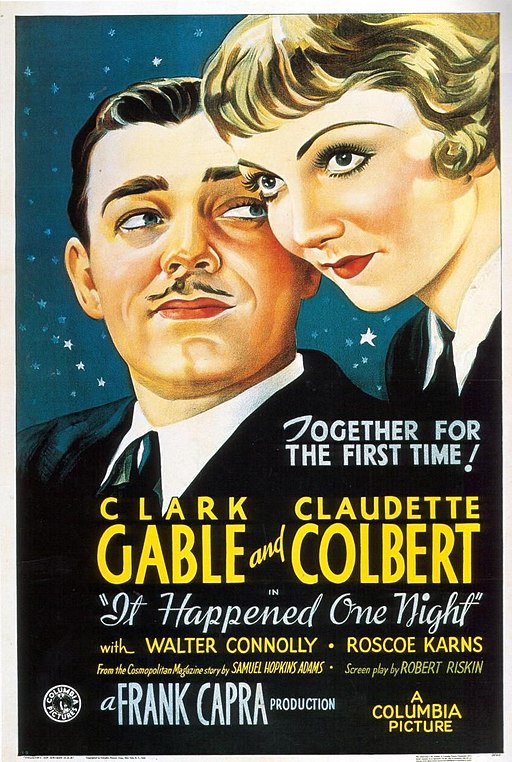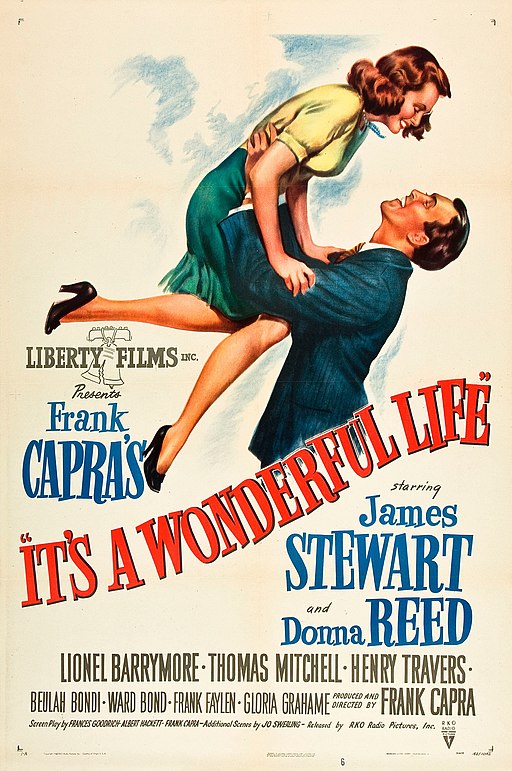Frank Capra
back| Full Name | Frank Russell Capra |
| Born | May 18, 1897 |
| Birthplace | Bisacquino, Sicily, Italy |
| Died | September 3, 1991 |
| Buried | Coachella Valley Public Cemetery, Coachella, California |
| Married to | Helen Howell (1923–1928), Lucille Warner (1928–1984, her death) |
| Children | Frank Capra Jr., Lucille Capra, Tom Capra |
| Notable films | Mr. Smith Goes to Washington - It's a Wonderful Life - Lost Horizon |
Frank Capra – “The American Dream Personified”
Frank Capra (1897–1991) was a Sicilian-born American film director, known for his influential role in Hollywood during the 1930s and 1940s. Moving to the U.S. as a child, Capra pursued chemical engineering before finding his calling in filmmaking. He rose to prominence with heartwarming, inspirational tales that championed the common man and celebrated American values. His collaboration with screenwriter Robert Riskin resulted in some of cinema's most beloved classics.
Key highlights of Capra's career include the creation of defining films like "It Happened One Night" (1934), which won five Oscars, "Mr. Smith Goes to Washington" (1939), and the perennial favorite "It’s a Wonderful Life" (1946). Capra served as the President of the Academy of Motion Picture Arts and Sciences and won three Best Director Oscars, showcasing his substantial impact on the industry.
Frank Capra was often referred to as the "American Dream personified," as his life story and films encapsulated the ideals of hope, success, and the triumph of the individual. Born in Italy and immigrated to the United States, Capra rose from humble beginnings to become one of the most celebrated directors in Hollywood.
Related
Frank Capra – Biography, movies and analysis of his work
Early Life
Frank Capra was born on May 18, 1897, in Bisacquino, Sicily, Italy. In 1903, his family immigrated to America, settling in Los Angeles, California. Capra's early life was marked by poverty, but he managed to attend Throop Institute (now Caltech) where he studied chemical engineering.
Early Career
After serving in the United States Army during World War I, Capra found work in the film industry through a chance meeting with actor/comedian Harry Langdon. He directed several successful films for Langdon before moving to Columbia Pictures, where he would find his greatest successes.
The Silent Movie Years
Frank Capra's silent movie period spanned the early years of his filmmaking career during the 1920s. Although he is best remembered for his work in sound films, particularly the feel-good movies he made during the 1930s and 1940s, his experiences in silent cinema were crucial to his development as a director.
Capra entered the film industry at a time when silent films dominated, initially working in various capacities including as a prop man, editor, and writer. His first directing opportunity came with the silent comedy short "Fultah Fisher's Boarding House" in 1922.
Development of Style:
The silent era was a formative period for Capra. He directed a series of comedy shorts for the Hal Roach studio and later worked at Harry Langdon’s production company, where he co-directed a number of silent feature films. These early experiences allowed him to hone his skills in visual storytelling, a crucial aspect of filmmaking that remained essential even as the industry transitioned to sound.
Transition to Sound:
Capra was among the directors who made a successful transition to sound films. His experience in silent cinema, where expression, body language, and visual composition were paramount, played a significant role in shaping his approach to filmmaking. He carried these skills into the sound era, creating films that were not only verbally witty but also visually engaging.
Legacy of the Silent Era:
Even though Capra's silent films are not as well-remembered as his later works, they played a crucial role in his development as a filmmaker. The silent era was a time of experimentation and learning for Capra, and the skills he acquired during this period laid the foundation for his subsequent success in Hollywood.
Hollywood Success
Capra's rise in Hollywood was meteoric. His ability to blend humor with deep emotional storytelling resonated with audiences. In 1934, he won his first Academy Award for Best Director for "It Happened One Night," which also became the first film to win all five major Academy Awards (Best Picture, Director, Actor, Actress, and Screenplay). He followed this success with a string of hits, including "Mr. Deeds Goes to Town" (1936), "Lost Horizon" (1937), "You Can’t Take It with You" (1938), and "Mr. Smith Goes to Washington" (1939).
His films often dealt with common people standing up against corruption and fighting for justice, reflecting Capra’s belief in the innate goodness of the human spirit. His collaboration with screenwriter Robert Riskin was particularly fruitful, resulting in many of his most beloved films.
World War II and Post-War Period
Capra's career was interrupted by World War II, during which he served in the US Army and produced the influential "Why We Fight" propaganda film series. After the war, he found it difficult to recapture his pre-war success. His post-war films, including the now-classic "It’s a Wonderful Life" (1946), initially received a lukewarm reception.
Later Years
In the 1950s, Capra’s career slowed, and he eventually retired from filmmaking. He wrote his autobiography, "The Name Above the Title," published in 1971, which provided insight into his life and career, although some aspects have been disputed for their accuracy.
Analysis of the filming style of Frank Capra
Frank Capra’s filmmaking style is distinguished by its humanism, optimism, and focus on the American Dream, with narratives that frequently celebrate the common man's values and indomitable spirit. His works are notable for their emotional depth, moral grounding, and ability to blend comedy with drama to create heartfelt and uplifting stories.
Storytelling and Themes
- Optimism and Humanism: Capra’s films are renowned for their inherent optimism and faith in humanity. He believed in the inherent goodness of people and often portrayed characters who triumphed over adversity through kindness, honesty, and perseverance.
- The Everyman Hero: Many of Capra’s films feature “everyman” protagonists – ordinary individuals who find themselves in extraordinary situations, often standing up against corruption and injustice.
- Social Commentary: Capra wasn’t afraid to tackle social issues and often used his films to comment on the socio-political climate of his time. His stories highlighted the struggles of the common man against oppressive systems and championed democratic values.
- American Dream: Capra’s works frequently explore themes related to the American Dream, emphasizing that success and happiness are attainable through hard work, integrity, and community.
Visual Style
- Dynamic Composition: Capra was known for his dynamic camera work and innovative use of composition to enhance the narrative. He employed a variety of shots and angles to convey emotion and drive the story forward.
- Deep Focus: Like many directors of his time, Capra utilized deep focus photography, allowing both the foreground and background to be in sharp focus, which added depth to the scenes and helped in storytelling.
- Facial Expressions and Close-ups: Capra often used close-ups to capture the nuanced performances of his actors, focusing on their facial expressions to convey the characters’ inner turmoil and emotions.
Collaboration with Actors
- Strong Performances: Capra was renowned for his ability to elicit strong performances from his actors. He worked with some of the biggest stars of his time, including James Stewart, Gary Cooper, and Claudette Colbert.
- Actor’s Director: Actors frequently praised Capra for his collaborative approach and his ability to create a supportive environment on set. He was known as an actor’s director, someone who understood performance and could guide actors to deliver their best.
Editing and Pacing
- Pacing: Capra’s films are noted for their tight pacing, with editing that ensures the story moves swiftly and retains the audience’s attention.
- Emphasis on Storytelling: Capra believed in the power of editing to shape a story. He was actively involved in the editing process, ensuring that every cut and transition served the narrative and enhanced the emotional impact of the film.
Music and Sound
- Music as a Narrative Tool: Capra used music effectively to enhance the emotional resonance of his films. He understood the power of a well-placed musical score to underscore the drama or highlight the comedic moments.
Awards and nominations for Frank Capra
Frank Capra was one of the most acclaimed directors of his time, and his work received numerous awards and nominations throughout his career.
Academy Awards (Oscars):
- 1934: Best Director for "It Happened One Night" (Won)
- 1936: Best Director for "Mr. Deeds Goes to Town" (Won)
- 1939: Best Director for "You Can't Take It with You" (Won)
- 1939: Best Picture for "You Can't Take It with You" (Won, as producer)
- 1941: Best Director for "Meet John Doe" (Nominated)
- 1944: Best Director for "It's a Wonderful Life" (Nominated)
- 1944: Best Picture for "It's a Wonderful Life" (Nominated, as producer)
Golden Globe Awards:
- 1947: Best Director for "It's a Wonderful Life" (Nominated)
Venice Film Festival:
- 1934: Best Foreign Film for "It Happened One Night" (Won)
- 1936: Best Director for "Mr. Deeds Goes to Town" (Won)
New York Film Critics Circle Awards:
- 1935: Best Director for "It Happened One Night" (Won)
- 1936: Best Director for "Mr. Deeds Goes to Town" (Won)
- 1938: Best Director for "You Can't Take It with You" (Won)
Directors Guild of America (DGA) Awards:
- 1938: Outstanding Directorial Achievement in Motion Pictures for "You Can't Take It with You" (Won)
- 1944: Outstanding Directorial Achievement in Motion Pictures for "It's a Wonderful Life" (Nominated)
Honorary Awards and Tributes:
- 1940: Irving G. Thalberg Memorial Award for consistently high-quality work (Academy Awards)
- 1959: Cecil B. DeMille Award for outstanding contributions to the world of entertainment (Golden Globe Awards)
- 1982: AFI Life Achievement Award from the American Film Institute for his contributions to the film industry
Frank Capra also received numerous other accolades and tributes throughout his career, including honorary degrees, lifetime achievement awards, and retrospectives celebrating his work. His films continue to be highly regarded and have left a lasting legacy on the world of cinema.
Quotes from Frank Capra:
Frank Capra was known for his wisdom and insight into both filmmaking and life, and he left behind a number of memorable quotes. Here are some of his most remarkable statements:
- On Filmmaking: “A hunch is creativity trying to tell you something.”
- On Life’s Struggles: “A man's hope measure's his civilization.”
- On Storytelling: “There are no rules in filmmaking. Only sins. And the cardinal sin is dullness.”
- On Success: “Success is three parts hard work and one part serendipity; this serendipity is a gift from the gods.”
- On Art and Commerce: “Art for art’s sake is just another piece of deodorized dogma.”
- On the Power of Film: “Film is a disease. When it infects your bloodstream, it takes over as the number one hormone; the antidote to film is more film.”
- On the Importance of Emotion: “A film is never really good unless the camera is an eye in the head of a poet.”
- On Life and Work: “Don’t follow trends, start trends.”
- On the Role of the Director: “The name above the title means more to me than money.”
- On the Human Spirit: “I made mistakes in drama. I thought drama was when actors cried. But drama is when the audience cries.”
The late success of “It’s a Wonderful Life”
"It's a Wonderful Life," directed by Frank Capra in 1946, is considered one of the greatest films in American cinema history. Though it received mixed reviews upon its initial release and was a box-office disappointment, the film has since become a holiday classic and is beloved by audiences worldwide.
Concept and Development
The film was based on a short story titled "The Greatest Gift" written by Philip Van Doren Stern. Capra was immediately drawn to the story’s uplifting message and saw its potential to be transformed into a feature film. He worked closely with a team of writers to develop the screenplay, including Frances Goodrich, Albert Hackett, and Jo Swerling.
Themes and Message
The film explores profound themes such as the value of life, the impact of one individual on the lives of others, and the importance of community. Its central message is that each person's life is valuable and has a meaningful impact on those around them, even if they don’t realize it.
Filmmaking Techniques
Capra's direction was integral to the film's success. He was known for his ability to elicit strong performances from his actors, and "It's a Wonderful Life" was no exception. James Stewart delivered one of his most memorable performances as George Bailey, a man who gets to see what life would have been like if he had never been born. Capra's use of deep focus photography, innovative special effects (especially in the sequences showing what life would be like without George), and his attention to detail in creating the town of Bedford Falls all contributed to the film’s lasting appeal.
Reception and Legacy
Initially, the film was not a commercial success and it even led to a financial loss for Capra's production company. However, its re-emergence on television during the holiday season in the 1970s and 1980s revived its popularity. Today, "It's a Wonderful Life" is considered a Christmas staple and is praised for its storytelling, performance, and its ability to resonate with audiences across different generations.
Capra considered "It's a Wonderful Life" his personal favorite among the films he directed, and it encapsulates many of the themes and stylistic elements that defined his career. The film's enduring popularity is a testament to Capra’s skill as a filmmaker and his ability to touch the hearts of audiences worldwide.
Private life, marriage and children
Frank Capra preferred to keep his personal life out of the spotlight. He somehow succeeded in doing just that.
Marriage
Capra was first married to Helen Howell in 1923 whom he divorced in 1928. In 1932 he married Lucille Warner. The couple met in 1929 when Lucille came to visit a friend of her at the filmset of “Flight” in San Diego, a movie Frank was directing.. Their marriage lasted for over fifty years, until Lucille’s death in 1984. They had a strong and supportive relationship, with Lucille playing a crucial role in Capra’s life and career, helping him navigate the challenges of Hollywood and providing stability at home.
Children
Frank and Lucille Capra had four children: Lucille, Frank Jr., Thomas, and John. Capra was known to be a dedicated father, and he worked to provide a stable and nurturing environment for his children, despite the demands of his career. His son, Frank Capra Jr., followed in his father’s footsteps, pursuing a career in the film industry and eventually becoming a prominent producer and studio executive.
Private Life and Personality
Capra was known for his strong work ethic, creativity, and dedication to his craft. He was deeply passionate about filmmaking, and he brought a meticulous attention to detail to all of his projects. Despite his success, Capra remained humble and grounded, often attributing his achievements to the talented collaborators he worked with, including actors, writers, and crew members.
He was a deeply spiritual man and this spirituality influenced both his personal life and his work. He was known to read the Bible daily and his films often explored themes of faith, redemption, and the triumph of the human spirit.
In his later years, Capra wrote his autobiography, "The Name Above the Title," which was published in 1971. In this work, he reflected on his life, career, and the experiences that shaped him as a filmmaker and as a person.
Overall, Frank Capra led a fulfilling life, rich with personal and professional achievements. He was a loving husband and father, a visionary filmmaker, and a man of deep faith and integrity.
Frank Capra’s death
Frank Capra passed away in his sleep of a heart attack on September 3, 1991, at the age of 94. At the time of his death, he was at his home in La Quinta, CaliforniaHe was interred at the Coachella Valley Public Cemetery in Coachella, California.
Legacy
Capra's legacy endures as one of the defining directors of classic Hollywood cinema. His ability to combine entertainment with deeper social messages has left a lasting impact on the industry. "It's a Wonderful Life," in particular, has become a timeless classic, gaining more popularity with each passing year and serving as an enduring testament to Capra’s genius and humanity.
Complete overview of Frank Capra’s movies:
1920s:
- 1922: "The Ballad of Fisher's Boarding House": A short film based on Rudyard Kipling’s poem.
- 1926: "Fultah Fisher's Boarding House": A silent short film adaptation of a Kipling poem, telling a story of love and betrayal.
- 1926: "The Strong Man": A comedy about a Belgian immigrant who becomes a US postal inspector.
- 1927: "Long Pants": A young man’s journey through various comedic misadventures as he tries to prove he's grown up.
- 1927: "For the Love of Mike": A romantic comedy about a young man’s struggles in love and life.
1930s:
- 1930: "Ladies of Leisure": A romantic drama about a wealthy artist who falls in love with a model.
- 1931: "Dirigible": An adventure drama focusing on an airship expedition to the South Pole.
- 1931: "The Miracle Woman": A drama about a fraudulent faith healer.
- 1932: "Forbidden": A romantic drama about a love affair between a librarian and a district attorney.
- 1932: "American Madness": A drama centered around a bank and its struggles during the Great Depression.
- 1933: "The Bitter Tea of General Yen": A pre-Code drama about a Western woman in war-torn China.
- 1933: "Lady for a Day": A comedy-drama about a street peddler who is transformed into a society lady.
- 1934: "It Happened One Night": A romantic comedy about a runaway heiress and a journalist. Won five Academy Awards.
- 1934: "Broadway Bill": A comedy-drama about horse racing.
- 1935: "Opera Hat": A short film, an edited version of "Broadway Bill."
- 1936: "Mr. Deeds Goes to Town": A romantic comedy about a small-town man who inherits a fortune. Won the Academy Award for Best Director.
- 1937: "Lost Horizon": A fantasy-adventure about a utopian society in the Himalayas.
- 1938: "You Can't Take It with You": A romantic comedy about a man from a wealthy family who falls in love with a woman from a quirky family. Won the Academy Award for Best Picture and Best Director.
- 1939: "Mr. Smith Goes to Washington": A political drama about a young senator fighting corruption. Nominated for 11 Academy Awards.
1940s:
- 1941: "Meet John Doe": A drama about a populist political movement.
- 1942: "Arsenic and Old Lace": A dark comedy about a man who discovers his aunts are serial killers.
- 1944: "Tunisian Victory": A documentary about the North African campaign in World War II, co-directed with others.
- 1946: "It's a Wonderful Life": A fantasy drama about a man who sees what life would have been like if he never existed. Nominated for five Academy Awards.
1950s:
-
1950: "Riding High": A musical comedy about horse racing, a remake of "Broadway Bill."
- 1951: "Here Comes the Groom": A romantic comedy about a reporter who adopts two European orphans.
- 1957: "The Pride and the Passion": A historical drama about the Peninsular War.
- 1959: "A Hole in the Head": A comedy about a widower and his relationship with his son.
1960s:
- 1961: "Pocketful of Miracles": A comedy-drama about a bootlegger who helps a street peddler. A remake of "Lady for a Day."

